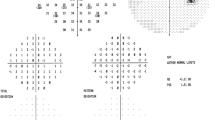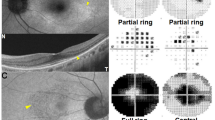Abstract
Purpose
To evaluate the effects of hydroxychloroquine on visual field and multifocal electroretinography (mfERG) and their correlations in patients taking hydroxychloroquine.
Methods
This was a cross-sectional study in which patients on hydroxychloroquine therapy underwent automated 10-2 threshold static visual field examination and mfERG recordings. Non-parametric unadjusted and age-adjusted Spearman correlation coefficients ρ were calculated between the cumulative dose of hydroxychloroquine and the visual field mean deviation (MD) and pattern standard deviation (PSD) values; and the mfERG response amplitudes and peak latencies. Correlation analysis was also performed between the visual field MD and PSD values and the mfERG response amplitudes and peak latencies.
Results
A total of 26 eyes in 13 patients were analyzed. The mean duration of hydroxychloroquine therapy was 4.9 years and the mean cumulative dose was 574 g. No significant correlation was found between the cumulative dose of hydroxychloroquine and the visual field MD and PSD values. There were significant correlations between the cumulative dose of hydroxychloroquine and mfERG N1 and P1 response amplitudes for the central rings (ring 1–3). The correlations between the dose of hydroxychloroquine and mfERG N1 and P1 response amplitudes were strongest for the paracentral ring 2 (ρ =−0.63 and ρ =−0.62, respectively, P = 0.001). Significant correlations were also found between the visual field MD values and mfERG response amplitudes of various ring eccentricities.
Conclusions
In patients on hydroxychloroquine, mfERG response amplitude correlated with both the 10-2 visual field MD values and with the cumulative dose of hydroxychloroquine used. The use of mfERG can provide objective measurement of retinal function in patients on hydroxychloroquine and may provide supplementary quantitative information to visual field findings.
Similar content being viewed by others
References
Shearer RV, Dubois EL (1967) Ocular changes induced by long-term hydroxychloroquine therapy. Am J Ophthalmol 64:245–252
Weiner A, Sandberg MA, Gaudio AR, Kini MM, Berson EL (1991) Hydroxychloroquine retinopathy. Am J Ophthalmol 112:528–534
Mavrikakis I, Sfikakis PP, Mavrikakis E, Rougas K, Nikolaou A, Kostopoulos C, Mavrikakis M (2003) The incidence of irreversible retinal toxicity in patients treated with hydroxychloroquine: a reappraisal. Ophthalmology 110:1321–1326
Finbloom DS, Silver K, Newsome DA, Gunkel R (1985) Comparison of hydroxychloroquine and chloroquine use and the development of retinal toxicity. J Rheumatol 12:692–694
Levy GD, Munz SJ, Paschal J, Cohen HB, Pince KJ, Peterson T et al (1997) Incidence of hydroxychloroquine retinopathy in 1,207 patients in a large multicenter outpatient practice. Arthritis Rheum 40:1482–1486
Bernstein HN (1991) Ocular safety of hydroxychloroquine. Ann Ophthalmolol 23:292–296
Rynes RI, Krohel G, Falbo A et al (1979) Ophthalmologic safety of long-term hydroxychloroquine treatment. Arthritis Rheum 22:832–836
Browning DJ (2002) Hydroxychloroquine and chloroquine retinopathy: screening for drug toxicity. Am J Ophthalmol 133:649–656
Marmor MF, Carr RE, Easterbrook M, Farjo AA, Mieler WF American Academy of Ophthalmology (2002) Recommendations on screening for chloroquine and hydroxychloroquine retinopathy: a report by the American Academy of Ophthalmology. Ophthalmology 109:1377–1382
Fielder A, Graham E, Jones S, Silman A, Tullo A (1998) Royal College of Ophthalmologists guidelines: ocular toxicity and hydroxychloroquine. Eye 12:907–909
Tzekov R (2005) Ocular toxicity due to chloroquine and hydroxychloroquine: electrophysiological and visual function correlates. Doc Ophthalmol 110:111–120
Neubauer AS, Samari-Kermani K, Schaller U, Welge-Lubetaen U, Rudolph G, Berninger T (2003) Detecting chloroquine retinopathy: electro-oculogram versus colour vision. Br J Ophthalmol 87:902–908
Easterbrook M (1984) The use of Amsler grids in early chloroquine retinopathy. Ophthalmology 91:1368–1372
Easterbrook M (1988) Ocular effects and safety of antimalarial agents. Am J Med 85:23–29
Carr RE, Henkind P, Rothfield N, Seigel IM (1968) Ocular toxicity of antimalarial drugs. Long-term follow-up. Am J Ophthalmol 66:738–744
Kellner U, Kraus H, Foerster MH (2000) Multifocal ERG in chloroquine retinopathy: regional variance of retinal dysfunction. Graefes Arch Clin Exp Ophthalmol 238:94–97
Maturi RK, Folk JC, Nichols B, Oetting TT, Kardon RH (1999) Hydroxychloroquine retinopathy. Arch Ophthalmol 117:1262–1263
So SC, Hedges TR, Schuman JS, Quireza ML (2003) Evaluation of hydroxychloroquine retinopathy with multifocal electroretinography. Ophthal Surg Lasers Imaging 34:251–258
Penrose PJ, Tzekov RT, Sutter EE, Fu AD, Allen AW Jr, Fung WE, Oxford KW (2003) Multifocal electroretinography evaluation for early detection of retinal dysfunction in patients taking hydroxychloroquine. Retina 23:503–512
Moschos MN, Moschos MM, Apostolopoulos M, Mallias JA, Bouros C, Theodossiadis GP (2004) Assessing hydroxychloroquine toxicity by the multifocal ERG. Doc Ophthalmol 108:47–53
Maturi RK, Yu M, Weleber RG (2004) Multifocal electroretinographic evaluation of long-term hydroxychloroquine users. Arch Ophthalmol 122:973–981
Tzekov RT, Serrato A, Marmor MF (2004) ERG findings in patients using hydroxychloroquine. Doc Ophthalmol 108:87–97
Lai TY, Chan WM, Li H, Lai RY, Lam DS (2005) Multifocal electroretinographic changes in patients receiving hydroxychloroquine therapy. Am J Ophthalmol 140:794–807
Marmor MF, Hood DC, Keating D, Kondo M, Seeliger MW, Miyake Y (2003) Guidelines for basic multifocal electroretinography (mfERG). Doc Ophthalmol 106:105–115
Seiple W, Vajaranant TS, Szlyk JP, Clemens C, Holopigian K, Paliga J, Badawi D, Carr RE (2003) Multifocal electroretinography as a function of age: the importance of normative values for older adults. Invest Ophthalmol Vis Sci 44:1783–1792
Tzekov RT, Gerth C, Werner JS (2004) Senescence of human multifocal electroretinogram components: a localized approach. Graefes Arch Clinc Exp Ophthalmol 242:549–560
Marmor MF (2005) The dilemma of hydroxychloroquine screening: new information from the multifocal ERG. Am J Ophthalmol 140:894–895
Author information
Authors and Affiliations
Corresponding author
Rights and permissions
About this article
Cite this article
Lai, T.Y.Y., Ngai, J.W.S., Chan, WM. et al. Visual Field and Multifocal Electroretinography and their Correlations in Patients on Hydroxychloroquine Therapy. Doc Ophthalmol 112, 177–187 (2006). https://doi.org/10.1007/s10633-006-9006-0
Received:
Accepted:
Published:
Issue Date:
DOI: https://doi.org/10.1007/s10633-006-9006-0




